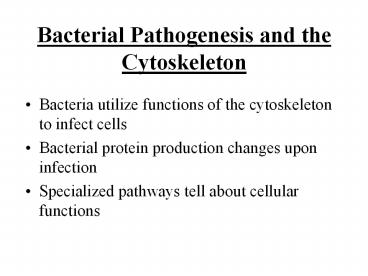Bacterial Pathogenesis and the Cytoskeleton - PowerPoint PPT Presentation
Title:
Bacterial Pathogenesis and the Cytoskeleton
Description:
Bacterial Pathogenesis and the Cytoskeleton. Bacteria utilize functions of the ... B.M., D.Bensimon, V.Croquette, PNAS 2000. dNTP-dependent motors ... – PowerPoint PPT presentation
Number of Views:253
Avg rating:3.0/5.0
Title: Bacterial Pathogenesis and the Cytoskeleton
1
Bacterial Pathogenesis and the Cytoskeleton
- Bacteria utilize functions of the cytoskeleton to
infect cells - Bacterial protein production changes upon
infection - Specialized pathways tell about cellular
functions
2
Background Readings
- Regulating Bacterial Expression by Methylation
(reviewed in Low et al., 2001. Infection and
Immunity 697197-7204) - Microbial pathogenesis and cytoskeletal function
(reviewed in Gruenheid Finlay. 2003. Nature
422775-81) - Chapter 16 in Molecular Biology of the Cell 4
(Alberts et al.)
3
(No Transcript)
4
Control of Pilus Production by DNA Methylation
From Low et al., 2001
5
Bacteria Bind Stronger with More Force
6
Molecular motors in bacteria how do pili pull?
- Pilus function
- twitching motility
- (unspecific adhesion to surface)
- interaction with host cell
- (specific adhesion)
- horizontal gene transfer
- Modelsystem Neisseria gonorrhoeae
7
Pilus-Dependent Propulsion
Neisseria gonorrhoeae produce type IV pili that
are 2-5 microns long
8
Functions of Type IV Pili
- Transformation
- Genetic Transfer
- Conjugation
- Phage Infection
- Virulence
- Twitching and Colony Motility
9
Pili Are Homopolymers of Pilin
6 nm
4 nm
Inner Membrane
Outer Membrane
10
- Pilus is a helical polymer
- - monomer pilin
- - pitch 4nm, 5 pilin per turn
- length up to 5µm, diameter 6nm
Forest et al Gene, 1997
11
(No Transcript)
12
(No Transcript)
13
Twitching Movements Involve Retraction of Fibers
14
Does the host cell sense the amount of force
generated by pilus retraction?
Accumulation of panCD44
Merz, A. et al Mol. Microbiol. 1999
Bacterial adhesion evokes host cell response
15
Current molecular model for pilus
retraction pilus is a dynamic polymer
16
We conclude for the most likely molecular
mechanism
A single pilT complex generates 110pN by an ATP
driven conformational change.
17
AAA ATPases
18
Is motor oligomerization involved in the
generation of forces in excess of 100pN?
- PilT belongs to the family of AAA ATPases
- AAA ATPases are involved in the dissociation
- of protein complexes
- in vitro PilT forms hexamers
Electron micrograph of a PilT homolog (TrbB)
19
Kaiser, D. Current Biol. 10R778 (2000)
20
ATP-dependent motors
Kinesin transports vesicles and mitochondria on
microtubules
Direct measurement of steps showed basic
stepsize is 8nm Variance of translocation per
time showed 1 ATP is hydrolized per step at
negligible load Tight mechanochemical coupling
21
dNTP-dependent motors
DNA polymerase replicates DNA
Replication rate follows a simple Arrhenius
law V v0exp(ndF/kBT) n 2nts or 4nts
B.M., D.Bensimon, V.Croquette, PNAS 2000
22
Translocation ratchet
Simulation
Flux of segments
23
Motors driven by proton-motive forces
Bacterial respiration creates a transmembrane pH
gradient. Proton flux from the outside to the
inside of the cell generates force. Example
E.coli flagella Induction of MotA expression.
The motor MotA is supposed to change conformation
upon proton translocation.
24
Kinetic Scheme For Kinesin Movement (Processive)
25
Kinetic Scheme for Myosin Movement on Actin
26
Bacterial gene transfer
- Biological relevance of bacterial gene transfer
- Genetic diversity. Escheria coli contains 17
foreign DNA. - Virulence. Pathogenicity islands are easily
transfered between bacteria. - Antibiotic resistance. Oral streptococci act as
genetic reservoirs and - transfer antibiotic resistance to pathogenic
bacteria.
Proposed molecular machine for DNA uptake
Promising tool to study the molecular mechanism
of DNA uptake































